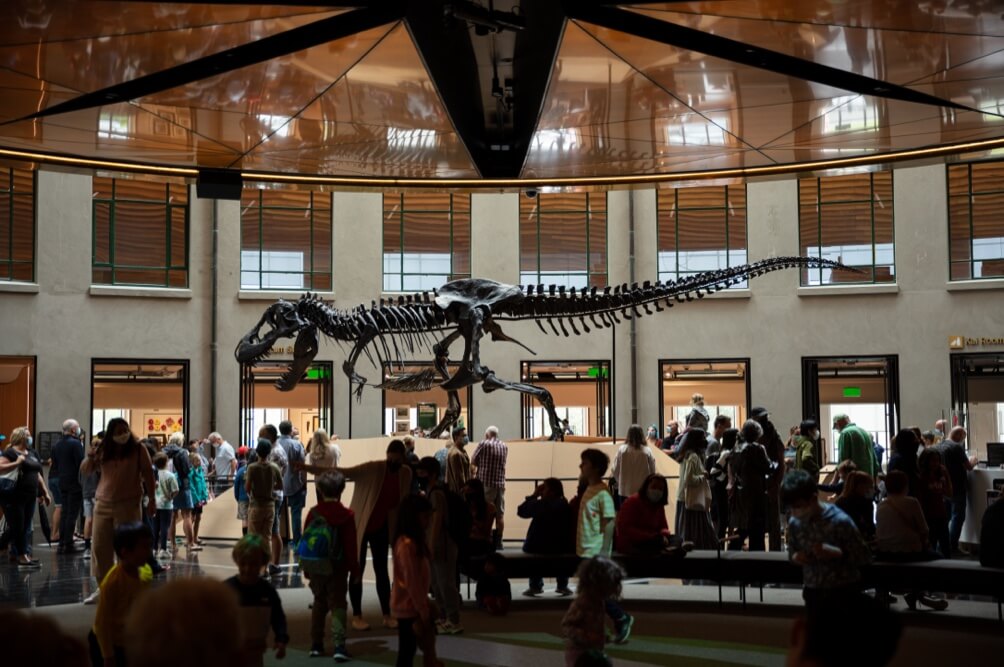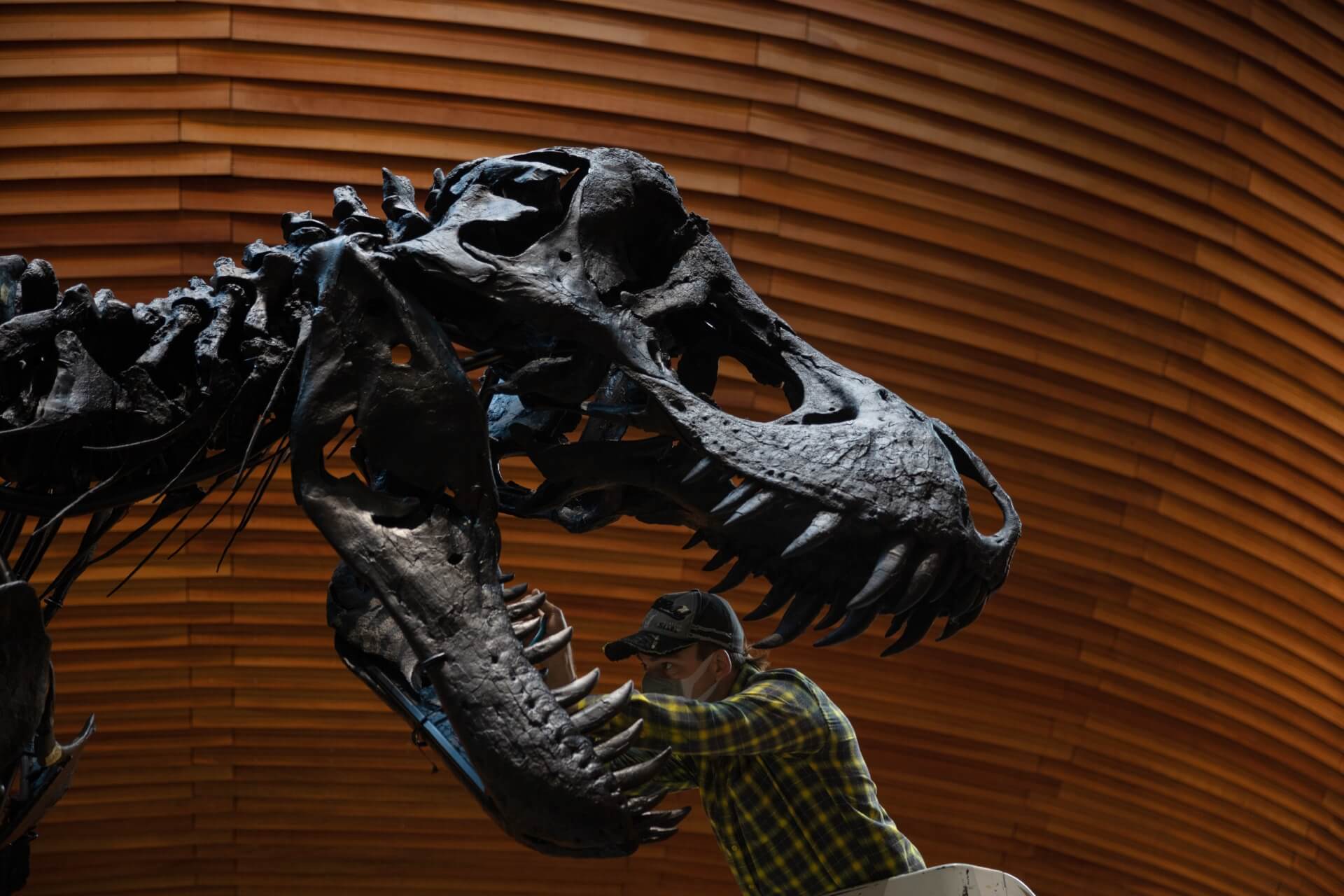Aug 24, 2022 What's On
Peter lifts his enormous head, scenting the hint of a rival on the breeze. Millions and millions of years in the future, once it has become blanketed in dusty prairie, humans will call this land “Wyoming”. But now, vast river systems criss-cross the North American continent, and the floodplain on which Peter will soon die is lushly forested and enriched by the subtropical air. Turtles and crocodiles populate the rivers; the vegetation above attracts the lumbering attention of the herbivores of the Late Cretaceous, Edmontosaurus and Triceratops among them. Carnivores, of course, come here to feed too. The biggest of them all are the Tyrannosaurus rex, including Peter and his rival. “Tyrannosaurus rex” translates from the Latin as “king of the tyrant lizards” — and this territory is soon to have a new despot.
Peter is old for a T. rex, perhaps nearing 28, the upper limit of the animal’s life span, and is a survivor of previous altercations that have etched their record on to his bones. He is no longer at his peak. His mobility is restricted by arthritis, his primacy susceptible to challenge from the younger competitor bearing down on him. But Peter is an apex predator, accustomed absolutely to dominance, and he doesn’t shy from the challenge emerging from the foliage. It will be his final mistake: the two vast bodies collide, the challenger out-manoeuvring his elder, wrapping his jaws around Peter’s left thigh in the strongest bite a terrestrial animal on this planet has ever possessed, ripping through the skin and muscle to gouge three parallel tooth marks into the bone. “Just like if you were chomping on a drumstick of chicken,” Dr John Nudds, co-author of a scientific report on Peter’s fossil, told Metro over Zoom from Lithuania, where he happened to be holidaying. Nudds, who for more than 30 years has been a palaeontologist at the University of Manchester, elaborated. “You would bite into that fleshy bit at the top of the thigh — this is exactly what another T. rex has done to Peter.”
The bite occurred some 67 million years ago. Now, 47% of Peter’s fossil — plus casts to replace the bones that didn’t survive the intervening ages — is on display at Auckland War Memorial Museum. One blustery autumn afternoon, just before Easter, Metro took a seat alongside the assembled broadcast media, with their drones and TV wardrobes, to watch a then-headless Peter, whose name comes from the fossil’s mystery lender, being pieced together for his first-ever residence in a museum. He stalked the area between the gift shop and the cafe in the South Atrium, growing ever more complete as wooden boxes labelled “CERVICAL RIBS” or “ANTERIOR DORSAL VERTEBRAE” were wheeled out from an anteroom to the half-dozen museum staff who were piecing the bones together. They paused often to consult the construction manual with which Peter travels.

Peter on display
Peter, his spine roughly parallel to the floor and his tail up to counterbalance the weight of his as-yet absent head, was being arranged into the most life-affirming pose possible, that in which he once hunted. But the connotations — bones appearing as if exhumed from a mausoleum, fatal wounds, and a length of time so enormous it sends the imagination wheeling into the realm of the infinite and one’s place in it — ushered the mind towards the concept of death, and the moment of Peter’s.
Out of death, life — or at least an ever-more-detailed portrait of it, though many details of Peter’s life and death remain a mystery. Whether he was indeed a male, for instance, whether he had been the antagonist or protagonist in the confrontation that ended with his death, or the reason for that battle. But as Dr David Burnham, another of that paper’s co-authors and a paleontologist at the University of Kansas, told Metro, much can be inferred from his remains. In the ecosystem of the Late Cretaceous, the only animal capable of inflicting a bite like that on Peter’s thigh was another Tyrannosaurus rex; ditto the other breakages on Peter’s hindlimbs. Peter’s flesh wasn’t consumed by this other animal — the bones were found in too small an area, too neatly resembling the positions they assumed in life — which means the victor exerted an enormous amount of energy in inflicting death, yet didn’t stop to recharge itself from the protein on offer.
“We think,” Burnham said, “it was just some kind of a vicious kill by another T. rex. Maybe they are fighting over territory. They fight over things we fight about: food, mates, children.” There was no shortage, Nudds said, of reasons for these animals to get into what he called “a scrap”. “They were not passive creatures.”
Nor were they rare. A 2021 study published in Science estimated that there had existed 2.5 billion T. rex individuals over 127,000 generations, or the roughly two million years the species survived. Yet there are very few fossils that have both survived and been discovered. (About 32 examples are on public display around the world.) The highly specific ingredients that fossilisation requires very rarely come together, Nudds explained.
“For anything to be fossilised is quite unusual. The skeleton has to be buried very quickly, before the bones start to decay by laying on the floor… [When] Peter died, the carcass lay on the floodplain, but very quickly there must’ve been a flood event, the channel overflowed, mud was quickly deposited on top of the skeleton and that’s how he came to be preserved.” At some point in the intervening millions of years while the fossilised bones lay buried — as other species evolved, prospered and went extinct, as humanity emerged to begin its as-yet comparatively brief tenancy on earth — an errant mineral dyed the fossils the dense obsidian black now on display.
Mostly, it was time — the 66.8 million years of time — that preoccupied the mind as we met Peter: time, and the fact that scholars like Nudds and Burnham have been able to dredge at least some knowledge of Peter’s existence after so long. “It is crazy,” Burnham told Metro. “The only thing we know is the present. We think about the future and we think about the past but the only thing we really have is the present. And just to say, ‘Well, this is not just the past but this is the deep past, the far past, millions of years.’”
The ages have caused life — at least of this epoch’s dominant animal — to shrink in scale. And it is Peter’s scale — four metres tall, 12 long — that, despite his familiarity with the specimen and the species, Burnham still finds seizing control of his thoughts. The mere fact of these animals makes an equally huge impression on us laypeople. “All of these things just all of a sudden happen, like ‘Oh my God, these things were alive!’ ‘I didn’t know these things were so big.’ To have that opportunity to have that moment with an animal that you’ve never seen before and have only ever heard about — a chance to see one, even if it is just the bones, is an incredible opportunity. It’s going to emote a feeling and you are going to walk away with something you are never going to forget.”
Peter the T.Rex is on display at Tāmaki Paenga Hira Auckland Museum.
–






